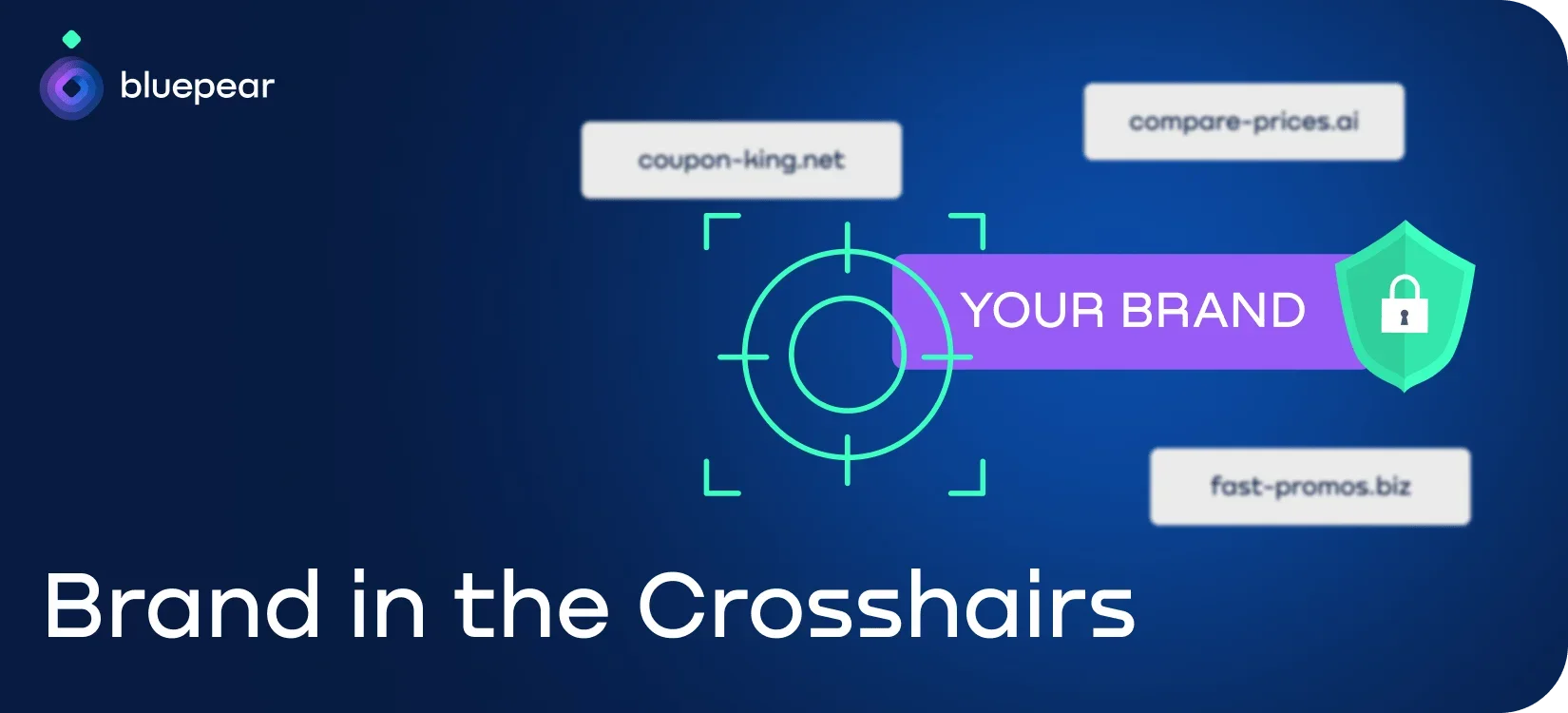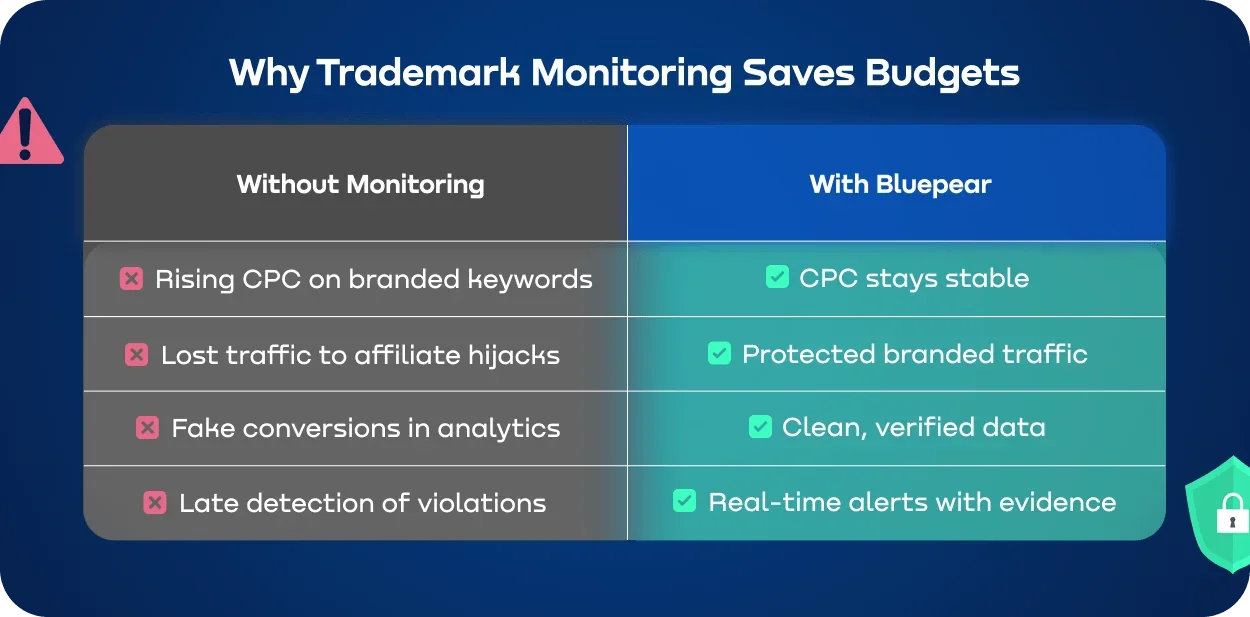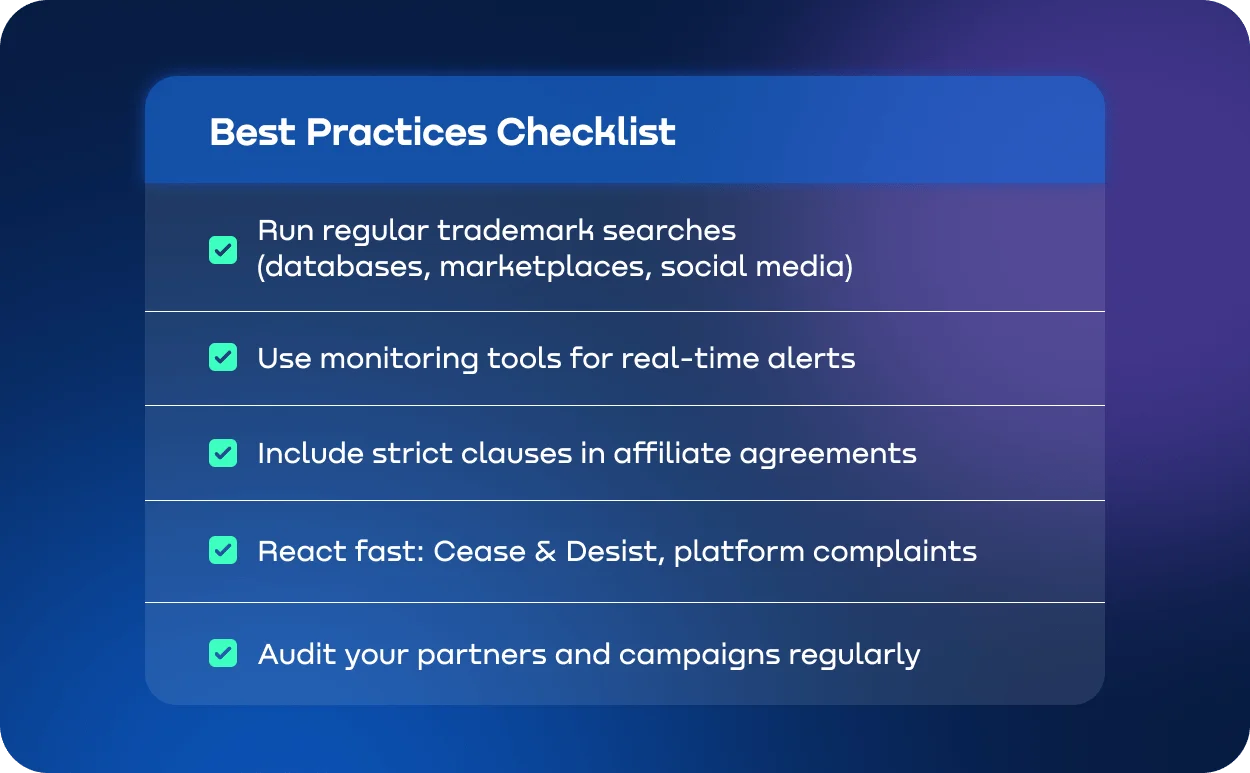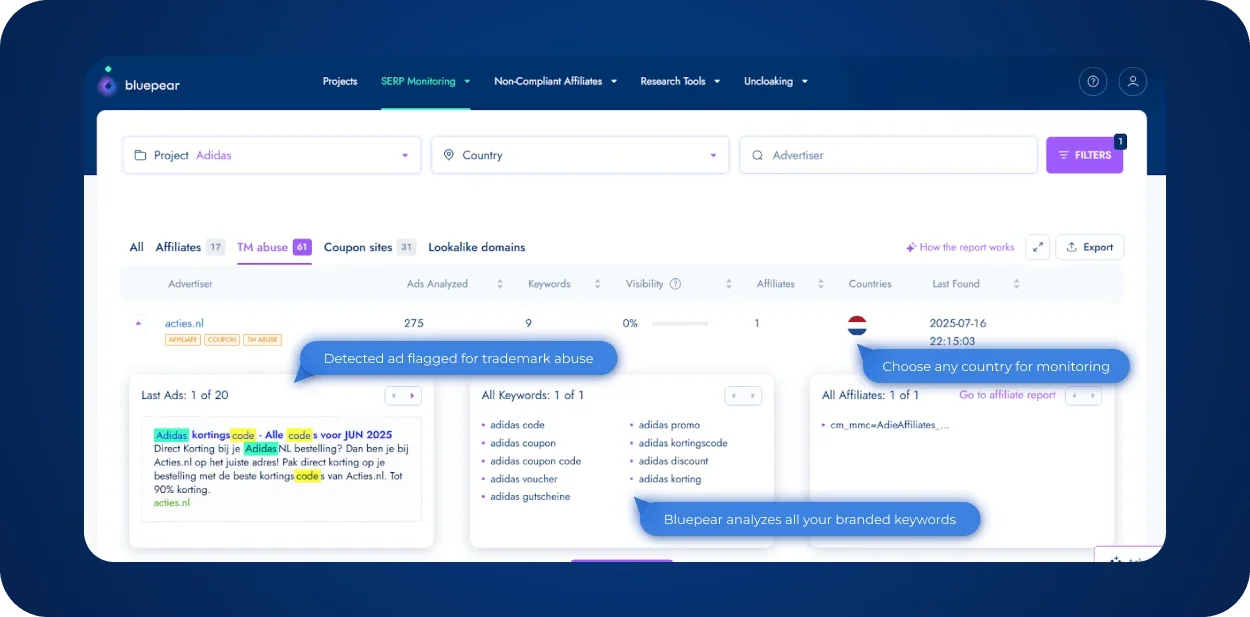
Contents
According to Search Engine Land, 75% of top brands reported falling victim to online trademark abuse. This means three out of four brands are hit by a trademark infringement. Unfortunately, that's just how things are now for digital marketers.
Are you sure that no one is bidding on your brand keywords today?
Trademark abuse is not just a legal issue, it is a real threat that affects companies’ budgets, sales, and reputation. Every click stolen by fraudsters is a lost conversion and a damaged customer relationship.
The recent statistics proves that brands should take trademark monitoring seriously now:
- • 57% of trademark professionals reported a rise in online trademark infringement in 2023, compared to previous years (World Trademark Review).
- • Trademark violation cases in the U.S. rose +15 % over the past five years, largely due to online misuse (PatentPC).
- • In 2023, global spending on brand protection services reached $2.3 billion, and is projected to climb to $5.8 billion by 2032 (Dataintelo).
For years, registering a TM felt like enough giving brands legal grounds and peace of mind. But in 2025, that’s no longer true. Tricky fraudsters now hide their activities. They use geo-targeting, website cloaking, and dayparting to avoid detection.
Most infringements happen behind your back, targeting regions or devices your team isn’t monitoring. Meanwhile, the damage piles up: inflated CPCs, affiliate leakage, and customer confusion.
Sometimes, it takes brands weeks to detect a trademark abuse incident — often after revenue is lost. If you don’t perform regular trademark infringement monitoring in paid search, marketplaces, and affiliate traffic, chances are you're already being targeted.
Let’s break down what trademark monitoring is and how trademark watch can save your brand.
What Is Trademark Monitoring?
Trademark infringement monitoring is the process of tracking how and where your brand is being used across digital and physical channels. It goes far beyond a single takedown request or a legal Cease & Desist letter. Monitoring means being proactive, not reactive.
There are different layers of trademark watch:
- • Offline trademark monitoring. This includes tracking unauthorized use of your brand in physical products, packaging, or store displays. Mostly relevant for counterfeit goods in retail and logistics.
- • Legal trademark watch. This means monitoring trademark applications and domain name registrations that might copy or imitate your brand. Helps catch infringement early, before it becomes harder to stop.
- • Digital trademark monitoring. It’s the most complex and fast-moving layer. Covers paid ads, affiliate traffic, social media, marketplaces, and domains — where violations often happen at scale and with intent to bypass detection.
In 2025, most brand interactions begin online, making that the primary battleground where TM abuse strikes. According to Salesforce, a staggering 87% of consumers start their product search online, and 70% of U.S. retail purchases are influenced by an online interaction with a brand.
Fraudsters can target your brand through search ads, social platforms, affiliate links, marketplaces, and domain hijacking. And unlike traditional media, digital abuse is fast, cheap, and often invisible unless you’re using a trademark watch service.
That’s why brands need an automated trademark monitoring service, not just human oversight. It’s about building a system that catches problems before they drain your ad budget or damage your reputation.
Why Brands Can’t Ignore Trademark Monitoring in 2025

Key threats to watch for:
- • Social media abuse. Fake brand accounts and misleading ads on platforms like Instagram, TikTok, and Facebook can hijack your identity and reach.
- • Marketplace impersonation. Sellers on Amazon, eBay, or Temu often list counterfeit or copycat products using your brand name to boost visibility.
- • Affiliate fraud. Unapproved partners use redirects, cloaking, or geo-targeting to hide brand bidding and steal conversions.
- • Paid search hijacking. Competitors or affiliates bid on your branded keywords, outranking your own ads and stealing traffic.
In April 2024, famous footwear brand Dr Martens filed a trademark infringement lawsuit in the UK High Court, accusing Temu of bidding on branded keywords like “Dr Martens” and “Airwair” in Google Ads to promote lookalike products.
Although the case is ongoing and no concrete loss figures have been publicly disclosed, the lawsuit highlights several critical issues:
- • Temu ads were shown ahead of the official Dr Martens listings, diverting traffic and potentially cannibalizing sales.
- • Analysts have commented that Temu often appears first in search results for many luxury-branded queries, affecting established brands’ visibility and conversions
- • Cases like these remind digital marketers: if you don’t perform trademark infringement monitoring, you're likely paying for others to reap your traffic.
Types of Trademark Abuse and Their Channels
| Abuse Type | Where It Happens | Example |
|---|---|---|
| Paid Search Hijacking | Google Ads, Bing Ads | Affiliates or competitors bidding on your brand keywords |
| Affiliate Link Abuse | Affiliate networks, cloaked redirects | Unauthorized partners rerouting branded traffic to earn commissions |
| Marketplace Impersonation | Amazon, eBay, Temu | Sellers using brand names or trademarks to list counterfeit or similar items |
| Social Media Infringement | Instagram, TikTok, Facebook, YouTube | Fake brand accounts, hashtags misuse, or ads mimicking brand content |
| Domain Hijacking | .com/.net/.org domains, international ccTLDs | Domains like brandname-shop.com or br4ndname.com redirecting to competitors |
| App Misuse | Apple App Store, Google Play | Imitation apps using similar names, icons, or descriptions |
What Happens If You Avoid Trademark Monitoring
When brands don’t actively perform trademark watch, the damage usually happens quietly. So, by the time you notice it, you’ve already lost money, visibility, or trust.
Brand damage comes first. A fake Instagram account starts running ads under your name, using your logo and product photos. Customers click, buy a knockoff, and then blame you when it doesn’t arrive. Without trademark watch service, you get the support tickets, the chargebacks, and the reputation hit — but none of the revenue.
SEO loss is another silent killer. Fraudsters launch lookalike websites using domains like brandname-store.com, often copying your content word for word. Search engines may rank them higher than your real site in some regions. Duplicate content, keyword overlap, and backlinks to fake pages can hurt your organic visibility and authority.
Conversion leakage is the most direct hit to revenue. An affiliate bids on your brand keyword in Google Ads and places their link above yours. A user clicks, converts, and the affiliate gets paid using your own traffic. Multiply this by hundreds of daily searches, and it’s easy to lose thousands per month without even realizing it.
It’s happening to brands every day unless they’re watching. Using a trademark monitoring service is how you stay in control.
Best Practices for Effective Trademark Monitoring

Trademark monitoring isn’t a one-time task — it’s a routine. To stay ahead of violations, brands need a trademark watch system, not just occasional checks.
- • Run regular checks. Monitor trademark databases, social media platforms, Google Ads, and affiliate networks on a consistent basis — not just when problems arise.
- • Set clear rules for partners. Include trademark usage policies in affiliate agreements. Define what’s allowed — like bidding on generic keywords — and strictly ban brand keyword hijacking or misleading ads.
- • Use automated tools. Search monitoring services like Bluepear help track brand bidding in paid search and detect affiliate violations across different GEOs. The trademark monitoring service captures evidence like ad copies and landing pages, making enforcement faster.
- • Act quickly on violations. Respond with cease & desist letters, file TM complaints in Google Ads, and report fake accounts or listings on social platforms and marketplaces.
- • Document every case. Keep records of violations, responses, and outcomes. This helps with repeat offenders, legal follow-ups, and identifying patterns over time.
Trademark watch is “preventive care” for brands. Without it, you have to solve costly problems instead of addressing small issues.
How Bluepear Helps Protect Your Brand

Bluepear is built to help brands stay in control of their traffic. The trademark monitoring service protects your brand value where it matters most — in paid search and affiliate marketing.
Bluepear gives brands a clear edge in defending their traffic, budget, and reputation. Instead of chasing violations manually, you get real-time visibility into what’s happening across paid search and affiliate channels.
Here’s what Bluepear does for you:
- • Performs 24/7 checks. The tool runs automated scans without manual effort and alerts you only when a real violation needs your attention.
- • Detects brand bidding in real time. See who’s targeting your branded keywords on Google or any other browser — with ad copy, positions, and landing page screenshots.
- • Uncovers cloaking and geo-targeting tactics. Violators often hide their ads by showing them only in specific regions or devices. Bluepear trademark watch service runs global checks and catches what internal teams usually miss.
- • Monitors affiliate traffic for policy breaches. Track rule-breaking affiliates automatically. Get proof, enforce terms, and cut off abuse before it drains your budget.
- • Delivers actionable evidence for enforcement. Every violation is logged by the trademark watch service with details you can send in a Cease & Desist or use in a Google Ads complaint.
If you care about ROI and protecting your brand, Bluepear is an essential trademark monitoring service.
Why 2025 Demands Proactive Trademark Monitoring
In 2025, trademark abuse moves faster and hides better than ever. AI-generated fake ads, resellers targeting new markets, and TikTok Shop sellers using your name without permission — these threats don’t show up in traditional reports.
Violations can appear in one region, disappear the next day, and still cost you traffic, sales, and customer trust.
Waiting to react is no longer enough. You need a trademark watch service that actively checks what’s happening across platforms and regions — before the damage is done. That’s why proactive trademark monitoring is now a must, not a backup plan.
Don’t wait for violations to hurt your bottom line. Start monitoring now.
FAQ
What is trademark monitoring?
Trademark watching is the ongoing process of tracking how your brand is used online and offline to catch unauthorized or misleading use before it causes harm.
How is trademark watch different from trademark registration?
Registration gives you legal ownership of a trademark, while trademark watch services help you detect when others misuse it — so you can protect it in practice.
Why do I need trademark monitoring if I’m not a big brand?
Even small brands are targeted — especially in paid search or affiliate schemes where abusers bet you won’t notice. Early monitoring prevents bigger problems later.
How can I detect unauthorized use of my trademark?
Use a trademark monitoring service that scans search ads, websites, marketplaces, and social media. Manual checks help, but automated monitoring covers more ground and catches hidden violations.
What’s the difference between Bluepear and a traditional trademark monitoring service?
Traditional services track legal filings or simple web mentions. Bluepear monitors paid search and affiliate channels in real time, with geo-specific checks, de-cloaking, and evidence capture.
Can Bluepear protect my brand across multiple countries?
Yes. Bluepear runs cross-geo monitoring, showing how your brand appears in different regions and detecting location-specific violations.
Is trademark infringement monitoring expensive?
Usually, it’s cheaper than the cost of lost traffic, stolen conversions, or legal cleanups. Bluepear also offers a free 7-day trial.

